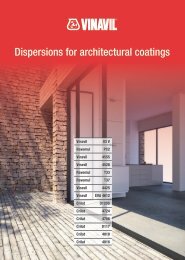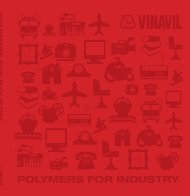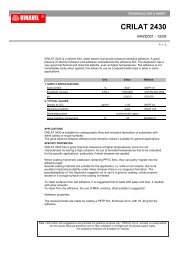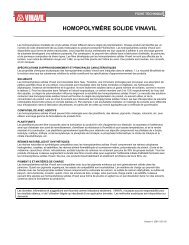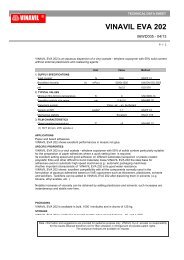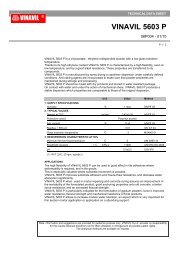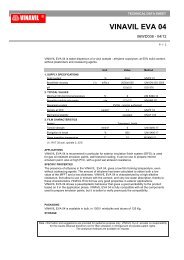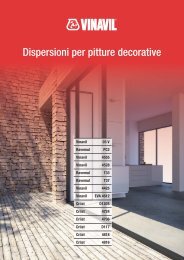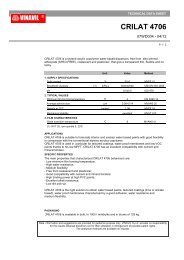Scheda tecnica K - vinavil
Scheda tecnica K - vinavil
Scheda tecnica K - vinavil
- No tags were found...
Create successful ePaper yourself
Turn your PDF publications into a flip-book with our unique Google optimized e-Paper software.
VINAVIL ®TECHNICAL DATA SHEETVINAVIL SOLID HOMOPOLYMER01B001-05/04P 1 - 4Vinavil solid homopolymers of vinyl acetate differ in degree of polymerization.Each product is identified by a code number directly related to the molecular weight of the product( Fikentscher constant).Vinavil solid homopolymers are available as translucent beads.Their most interesting property is their ability to adhere to an extremely wide range of substratesdevelloping strong adhesive bonds.Therefore they can be employed in the manufacture of adhesives, paints, and composition boardsof various types.The films developed by Vinavil solid homopolymers are not affected by light. Their averagerefractive index is 1.462, that is, very close the glassone.They are neutral, not corrosive, and not toxic products.SUPPLY SPECIFICATIONS AND MAIN PROPERTIESThe chemical and physical properties of Vinavil solid homopolymers are shown in table 1.The Brookfield Viscosity of the solution as well as the volatile substances of the solid constitutethe product supply specifications.SOLUBILITYVinavil solid homopolymers are insoluble in water.However, prolonged immersion may cause them to take up small quantities of water and swell.They are insoluble in mineral and vegetal oils, aliphatic hydrocarbons, turpentine and glycerol.They are readily soluble in a large number of solvents, as shown in table 2.To dissolve them in ethanol and isopropyl alcohol a certain amount (i.e., 5 and 12%respectively) of water must be added. Polymerization degree widely affect the solubility ofVinavil solid homopolymers.The viscosity of the solutions containing Vinavil solid homopolymers is depending of the degreeof polymerization of the product, solvent used, and product concentration.When selecting the solvent to dissolve Vinavil solid homopolymer, the evaporation rates ofindividual solvent must be taken into account (table 2). For example, it is desirable to adopt amixture of solvents with different evaporation rates in the manufacture of paints, especially ofthose to be applied by the spray method.COMPATIBILITY WITH ADDITIVESVinavil solid homopolymers can be mixed with plasticizers, resins, pigments, extenders,dyestuffs, etc. to obtain a wide range of final product formulations.PLASTICIZERSPlasticizers can be incorporated in the formulation of the final product to increase its elasticity,flexibility, and adhesion as well as to lower its softening point, improve its resistance to moistureand to low temperatures, and make it combustion-resistant.The plasticizers usually specified to attain these objectives include n-butyl, isobutyl, methyl,ethyl, and benzybutyl phthalates; tricresyl phosphate; trichloroethyl phosphate; tributyl citrateand acetyltributyl citrate; etc.NATURAL AND SYNTHETIC RESINSNatural and synthetic resins showing compatibility with Vinavil solid homopolymers includehydrogenated, oxidized, and esterified rosin; phenol-formaldehyde and cumarone-indene resins;phenol, urea, and melamine precondensates; chlorinated rubber; nitrocellulose; celluloseacetate butyrate containing no more than 30% of acetyl groups.All the above compounds and products impart hardness to the films and are useful to increasethe initial tack of adhesives formulated with Vinavil solid homopolymers, and improvewaterproofs and gloss of their films, etc.PIGMENT, EXTENDS, AND FILTERComplete compatibility for all the inorganic pigments that are usually employed in paints can beclaimed for Vinavil solid homopolymers. As to organic pigments, compatibility testing is desirableData, information and suggestions are provided for guidance purpose only. VINAVIL S.p.A. accepts no responsabilityfor the results obtained therefrom,nor for their utilization in infringement of possible patent rights.The analytical methods are available on request.
VINAVIL ®TECHNICAL DATA SHEETVINAVIL SOLID HOMOPOLYMER01B001-05/04P 2 - 4before they are used.Extenders and fillers that can be safely specified with Vinavil solid homopolymers includecalcium carbonate, calcium sulfate dihydrate, barium sulfate, bentonite, kaolin, quartz, mica,wood sawdust, and cork, as well as any other inert extender.The above additives can be added to Vinavil solid homopolymers as powder with stirring or bydissolving them in one of the solvents included in the final product formulation.APPLICATIONSPaintsVinavil solid homopolymers are used in the manufacture of primers and finish paint to be appliedonto wood, composition board, paper, paperboard, etc. In this industry Vinavil solidhomopolymers with low or medium degrees of polymerisation are generally preferred on accountof their stonger adhesive properties, the opportunity to prepare solution with high solid contentsfrom them, and their greater compatibility with other resins such as nitrocellulose, celluloseacetate butyrate, chlorinated rubber etc.Paints formulated with Vinavil solid homopolymers and the above-mentioned resins areparticularly suitable to coat paper, cellophane and aluminium foil, since they enable materialscoated with them to be heatsealed.Since Vinavil solid homopolymers are non toxic, the paints containing them can be used tomanufacture containers that come in contact with foods.Vinavil solid homopolymers with high degrees of polymerization are particularly useful incombination with nitrocellulose and alkyd resins in the manufacture of ovendried enamels formetals.AdhesivesAs adhesives, Vinavil solid homopolymers are used both in solution and as hotmelts to bondsubstrates of various types.Solvent-based adhesives can be used for direct bonding as such. They can also be used forheat-sealing after solvent evaporation. In this application, due account must be taken of thesoftening temperature of each Vinavil solid homopolymers (table 1).Addition of plasticizers, natural or esterified rosin, cumarone resin, terpene resin, etc. to Vinavilsolid homopolymers is necessary when hotmelts are prepared from the latter.The main applications of hotmelts made with Vinavil solid homopolymers are book - and journalbindingand automatic packaging of various products.Printins inksAs a results of the strength of the adhesive bonds they can develop on many types ofsubstrates, Vinavil solid homopolymer can be used quite successfully to bind pigments in themanufacture of inks for solvent rotogravure and silk-screen printing on many materials, such asaluminium foil, cellophane, fiber glass tissues, etc.The most frequently used solvents are denatured alcohol,ethyl acetate, and acetone. However,when solvent evaporation must be delayed, small quantities of solvents with higher boilingpoints can be added.The most suitable Vinavil solid homopolymers are those with low and medium degrees ofpolymerization.Composition boardVinavil solid homopolymers can be used advantageously as binding agents in the manufactureof compositions of several materials, including textile fibres, granulated cork, wood sawdust, etc.An important application in this sector is the manufacture of moldings and frames for thefurniture industry, and composition board for coffins. Wood sawdust and, occasionally, a mineralextender is usually dry-mixed with a binder, that is, Vinavil K 115 (a product with a high degreeof polymerization). The solvents and release agents are added to the mixture later stirring till ahomogeneous mass result.Chemical industryData, information and suggestions are provided for guidance purpose only. VINAVIL S.p.A. accepts no responsabilityfor the results obtained therefrom,nor for their utilization in infringement of possible patent rights.The analytical methods are available on request.
VINAVIL ®TECHNICAL DATA SHEETVINAVIL SOLID HOMOPOLYMER01B001-05/04P 3 - 4Vinavil PACKAGING solid homopolymers are used as the raw materials in the synthesis of polyvinyl alcoholand polyvinyl acetals, such as polyvinyl formal and butyrral.Vinavil solid homopolymers are available in 25 Kg bags.STORAGEVinavil solid homopolymers must be stored at temperatures lower than 30°C to avoid beadscaking.Table 1 - Physical-Chemical propertiesVINAVIL K 40UnitValueMethodK Values 40±2 MVPF 12Brookfield viscosity (1) mPa.s 26±6MVPF 11Softening range °C 83÷101 K. SarnowVolatile substancesVINAVIL K 50% 1.5 max MVPF 09K values 50±3 MVPF 12Brookfield viscosity (2) mPa.s 73±13MVPF 11Softening range °C 100÷119 K. SarnowVolatile substancesVINAVIL K 55% 1.5 max MVPF 09K values 54±3 MVPF 12Brookfield viscosity (3) mPa.s 13±2MVPF 11Softening range °C 114÷125 K. SarnowVolatile substancesVINAVIL K 60% 1.5 max MVPF 09K values 62±3 MVPF 12Brookfield viscosity (4) mPa.s 25±5MVPF 11Softening range °C 145÷165 K. SarnowVolatile substancesVINAVIL K 70% 1.5 max MVPF 09K values 72±3 MVPF 12Brookfield viscosity (5) mPa.s 9±2MVPF 11Softening range °C 195÷225 K. SarnowVolatile substancesVINAVIL K 115% 1.5 max MVPF 09K values 118±5 MVPF 12Brookfield viscosity (6) mPa.s 16±4MVPF 11Softening range (7) °C (7)K. SarnowVolatile substances(7)decomposes before softning% 1.5 max MVPF 09Data, information and suggestions are provided for guidance purpose only. VINAVIL S.p.A. accepts no responsabilityfor the results obtained therefrom,nor for their utilization in infringement of possible patent rights.The analytical methods are available on request.
VINAVIL ®TECHNICAL DATA SHEETVINAVIL SOLID HOMOPOLYMER01B001-05/04P 4 - 4(1)(2)(3)(4)(5)(6)ethyl acetate solution at 20%, Mod. LVT (ULA), 12 rpmethyl acetate solution at 20%, Mod. LVT (ULA), 6 rpmethyl acetate solution at 10%, Mod. LVT (ULA), 30 rpmethyl acetate solution at 10%, Mod. LVT (ULA), 12 rpmethyl acetate solution at 5% Mod. LVT (ULA), 30 rpmethyl acetate solution at 2%, Mod. LVT (ULA), 30 rpmTable 2 - Solubility of Vinavil solid homopolymers in solventsSolventSolubility of VinavilBoiling range(°C )Evaporationtime relative toethylether =1Flash point(°C )Acetone Excellent 55-56 2.1 - 17Cyclohexil acetate Good 170-177 77 57Amyl acetate Good 135-140 13 25Benzene Excellent 80-813 - 8Benzyl alcohol Good 204-208 1770 96Butanol used as a diluent 114-118 33 34Butanediol Excellent 164-176 163 60Butyl acetate Excellent 121-127 11.8 25Cyclohexanone Excellent 156-163 40 44Diacetone alcohol Excellent 155-165 147 45Ethanol denaturad Good 788.3 18Ethyl acetate Excellent 74-78 2.9 - 8Ethylene glycol acetate Excellent 149-160 52 47Ethylene polypropyleneglycol Good 190-200 970 93Isopropyl alcohol used as a diluent 80-8121 18Methanol Good 64-65 6.3 6.5Methyl acetate Excellent 56-62 2.2 - 13Methycyclohexanone Excellent 165-171 47 48Methylene chloride Excellent 39-41 1.8 Non flammableMethylene glycol Good 120-130 34.5 36Methylene glycol acetate Good 138-152 35 44Toluene Excellent 109.5-110.5 6.1 7Trichloroethylene Good 85-87 3.8 Non flammableXylene used as a diluent 136-140 13.5 23Data, information and suggestions are provided for guidance purpose only. VINAVIL S.p.A. accepts no responsabilityfor the results obtained therefrom,nor for their utilization in infringement of possible patent rights.The analytical methods are available on request.





